Alright, we're now going to eject a lander unit to see if it is possible to land. We're only able to shoot it out as a projectile from our orbiting spacecraft, and boost once right before hitting the ground. It is therefore important that we angle it correclty and consider a couple of things before shooting it off. Ideally we want it to land with a velocety bellow 3 m/s, and of course we don't want it to get fried on its way down. We'll need a way to slow the craft down, as there is now way it goes into the atmosphere at and has a starting velocity of 3m/s when launched from our spacecraft with a significantly higher velocity. It's also gonna accelerate against the planet surface so what could slow it down? The answer is; we're going to introduce the most dreaded consept for any physician... drag!
Now what is drag? Drag is a form of friction caused by particles in the atmosphere, in other words the air colliding with objects and excerting a force upon them. You can actually feel this effect in practice when stretching your hand out from a car window or when running really fast. This force relies on the relative velocity between the moving air and the object they're hitting as can be seen in the formula we were given by our brilliant scientists at NASA: \(F_d = \frac{1}{2}\rho C_d Av_{drag}^2\)
(\(F_d\)) is the air resistance experienced by a body with cross-sectional area (A), travelling with velocity (v) with respect to air with density (ρ). The constant (Cd) is a dimensional variable called the drag coefficient, which in general is not a constant. The force of air resistance acts opposite to the direction of motion.)
Put in simpler terms, the force the air excerts on you is relient on:
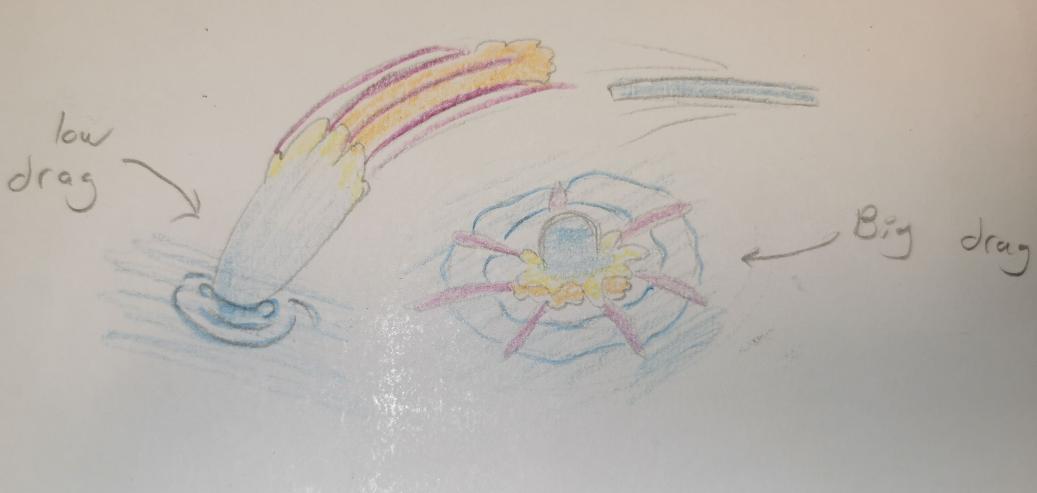
the area; the larger of an area the air collides with the more particles excert a force upon it, this is why parrachutes are used in sky diving; they have a large enough area to slow you down to a safe velocity as opposed to freefaling all the way to the ground with your own bodies conparatively
your velocity relative to it; if you travel with the same direction and velocity as the air, it's equivalent to there being no wind right? And we all know from experience that th faster we move or the greater the air speed, the more we can feel it, ergo higher force excerted.
the dencity; the more particles that hit you, similarly to a greater area, the more force is excerted on you. Greater dencity basicallly is just putting more atoms in a smaller volume of space. So a normal amount of air molecules by ocean level on earth is about 10 trillion, that's a one with 12 zeros behind it! while on top of mount everest, it is less than half; at 4 trillion. The reason the air is so much thinner up here is due to hydrostatic equalibrium, meaning the air is unable to force the air beneath in farther down and the air above it farhter up, due to the sum or forces acting upon it being 0.
The sharp-eyed of you may have already noticed why this is such a nightmare to calculate; it's because the force is directly influenced by the velocity, but the force also directly influences the velocity right back. So we have ourselves a little bit of a feedback loop here, which has to be solved numerically, meaning we look at a bunch of tiny time steps like in leapfrog and eulers method.
We already know our spacecraft's velocety, and by proxy our lander unit's velocety, relative to the planet, but as mentioned we're more interested in how fast it moves compared to the air in the atmosphere, as this is what will be slowing down our spacecraft. This relative velocity \(v_{drag}\) is given by: \(v_{drag} = |\vec{v}-\vec{w}|\) where:
\(\vec{v}:\text{ our spacecraft's velocity relative to lajaland}\)
\(\vec{w}: \text{the angular velocity of the atmosphere as a function of the postion }\)
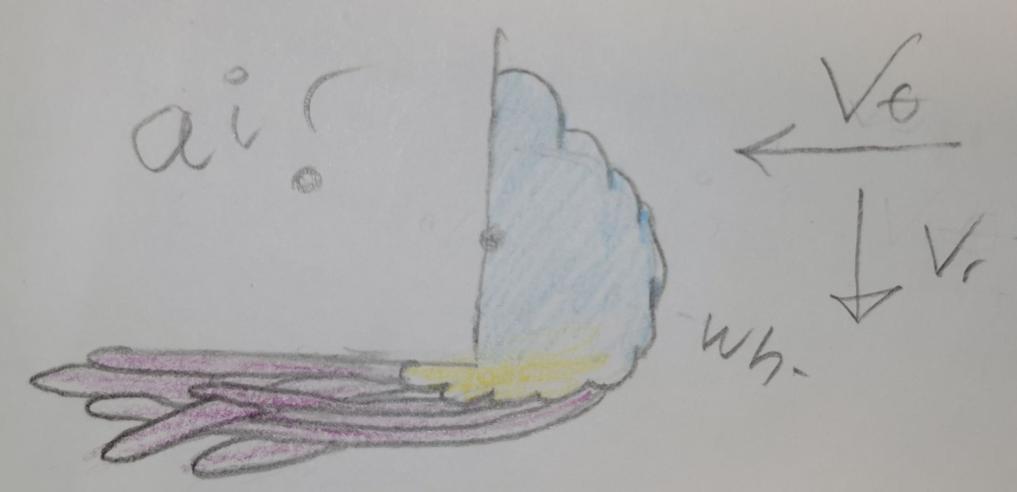 Before we start looking at when to deploy our parachute I want to look a bit at our decomposed velocities: \(v_{\theta}\space(\text{velocity tangential to the planet surface}) \space and \) \(v_r (\text{velocity directly toward or away from the planet's centre})\), over an extended period of time. First, we'll look at \(v_{\theta}\); in this direction our sattelite will only have one force acting uponit: the air friction. This means that \(v_{\theta}\) will gradually slow down, and the force caused by the friction from the air will decrease, until it's moving at the same velocity as the air surrounding the landing unit. \(v_r\) on the other hand has two forces acting on it in a tugg-of-war. The drag and the gravitational pull. Meaning it will never move at the same velocity as the air surrounding it, however it can reach a state of equalibrium between the forces where \(\sum{\vec{F}}=0\). Due to newton's second law of motion we know that it will move at a constant velocity, when this occurs.
Before we start looking at when to deploy our parachute I want to look a bit at our decomposed velocities: \(v_{\theta}\space(\text{velocity tangential to the planet surface}) \space and \) \(v_r (\text{velocity directly toward or away from the planet's centre})\), over an extended period of time. First, we'll look at \(v_{\theta}\); in this direction our sattelite will only have one force acting uponit: the air friction. This means that \(v_{\theta}\) will gradually slow down, and the force caused by the friction from the air will decrease, until it's moving at the same velocity as the air surrounding the landing unit. \(v_r\) on the other hand has two forces acting on it in a tugg-of-war. The drag and the gravitational pull. Meaning it will never move at the same velocity as the air surrounding it, however it can reach a state of equalibrium between the forces where \(\sum{\vec{F}}=0\). Due to newton's second law of motion we know that it will move at a constant velocity, when this occurs.

The velocity where this happens is what is known as the terminal velocity of an object. It can be expressed by \(v_{terminal} = \sqrt{\frac{2mg}{\rho C_d A}}\) and is found by setting \(F_d = G => \frac{1}{2}\rho C_d Av_{drag}^2=mg\) and solving for \(v_{drag}\).
m: lander unit mass
g: gravitational acceleration on Lajaland
A: cross-section of landing unit
This will be important to consider when deciding when to deploy our parachute, since the pressure \(P=\frac{F}{A} \space\text{cannot exceed}\space10^7pc\). This could be caused by for example deploying our parachute too early, leading to very high drag, or by our velocity being very high. 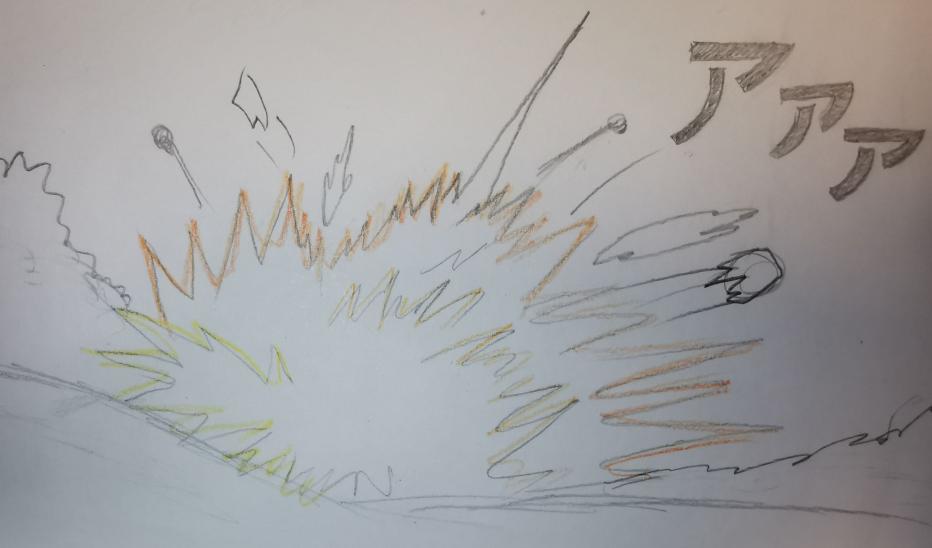 On that topic, we want to slow the landing unit as much as we can before deploying our parachute, to achieve this we plan on making a very challow approach into the atmosphere, which wil mean most of our initial velocity is in the tangential direction (\(v_{\theta}\)), in other words: most of the initial velocity we give the craft will be halted by drag. This approach also allows our landing craft a longer period of tile to achieve terminal velocity. Meaning we'll end up with a velocity mostly caused by Lajaland's gravitational pull. If we were to exceed the 107pc limit, by early deployment, high velocity or other means, our landing unit will turn into a toasty crisp before it strikes the planet surface. We in other words, after reducing our velocity with the landing craft alone, we need to find the point where the air dencity \(\rho\) isn't increasing much or at all, and our velocity is as near terminal as we can get it. If you recall, we said our model assumed an adibatic atmosphere close to the planet's surface, this means the pressure(\(P\)) divided by the air dencity (\(\rho\)) is the same throughout the layer: \(\frac{P}{\rho}=constant\). Our takeaway from this model here is that the pressure and dencity increase a lot slower when we get close to the surface, meaning we'll be deploying the parachute pretty close to the ground. This means vr will be at, or very close to terminal velocity and \(\rho\) will have a pretty linear increase, as opposed to the exponential one farther up in the atmosphere. We can then figure out the required area of the parachute by replacing Fd with G and solving for A, giving us:
On that topic, we want to slow the landing unit as much as we can before deploying our parachute, to achieve this we plan on making a very challow approach into the atmosphere, which wil mean most of our initial velocity is in the tangential direction (\(v_{\theta}\)), in other words: most of the initial velocity we give the craft will be halted by drag. This approach also allows our landing craft a longer period of tile to achieve terminal velocity. Meaning we'll end up with a velocity mostly caused by Lajaland's gravitational pull. If we were to exceed the 107pc limit, by early deployment, high velocity or other means, our landing unit will turn into a toasty crisp before it strikes the planet surface. We in other words, after reducing our velocity with the landing craft alone, we need to find the point where the air dencity \(\rho\) isn't increasing much or at all, and our velocity is as near terminal as we can get it. If you recall, we said our model assumed an adibatic atmosphere close to the planet's surface, this means the pressure(\(P\)) divided by the air dencity (\(\rho\)) is the same throughout the layer: \(\frac{P}{\rho}=constant\). Our takeaway from this model here is that the pressure and dencity increase a lot slower when we get close to the surface, meaning we'll be deploying the parachute pretty close to the ground. This means vr will be at, or very close to terminal velocity and \(\rho\) will have a pretty linear increase, as opposed to the exponential one farther up in the atmosphere. We can then figure out the required area of the parachute by replacing Fd with G and solving for A, giving us:
\(A = \frac{2mg}{\rho C_dv_{safe}^2}\)where:
vsafe: upper velocity where we still have a soft landing; 3m/s
The rest of the variables are explained farther up
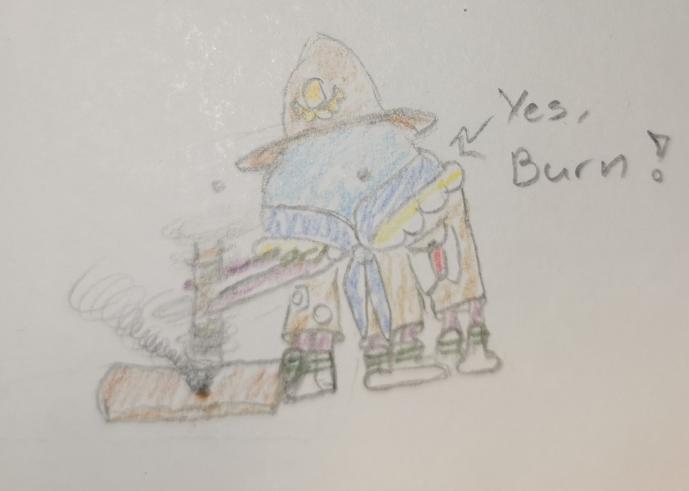 If we take a gander at Fd again we can see that increasing the area, wich we do by deploying our parachute, leads to mure force. Since the force upwards is now much greater than gravity pulling us downwards, we will start to slow even more. This is why having the parachute is so crutial. It allows us to have less drag farther up in the atmosphere to avoid burning up, but still allows us to have hore drag close to the surface to soften the blow. Finally our thrusters will give us a final push to avoid overstepping our 3m/s mark. The force of which we calculate with the formula:
If we take a gander at Fd again we can see that increasing the area, wich we do by deploying our parachute, leads to mure force. Since the force upwards is now much greater than gravity pulling us downwards, we will start to slow even more. This is why having the parachute is so crutial. It allows us to have less drag farther up in the atmosphere to avoid burning up, but still allows us to have hore drag close to the surface to soften the blow. Finally our thrusters will give us a final push to avoid overstepping our 3m/s mark. The force of which we calculate with the formula:
\(F_L = \frac{1}{2}\rho C_d A(v_{terminal}^2-v_{safe}^2)\)
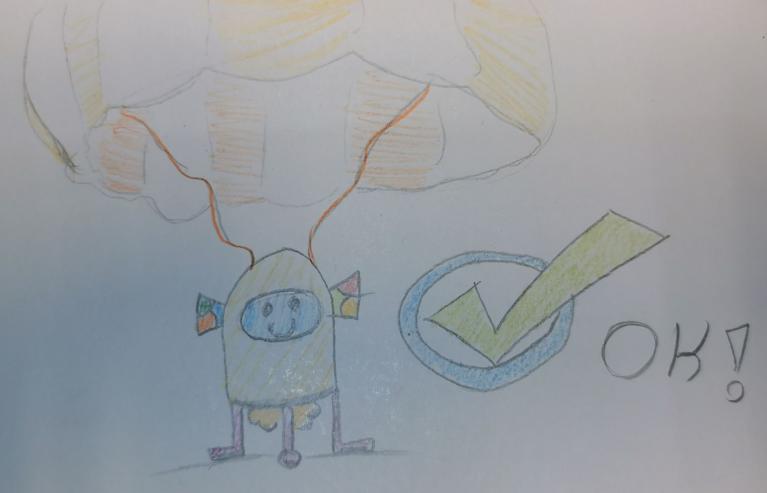 Now we just need to plop in a couple of variables in our formulas and we'll be set for landing!
Now we just need to plop in a couple of variables in our formulas and we'll be set for landing!

